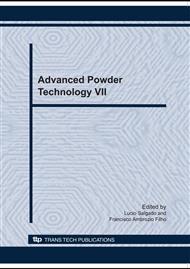[1]
A. Atkinson, et al.: Nature Materials Vol 3 (1) (2004), p.17.
Google Scholar
[2]
N.Q. Minh: J. Am. Ceram. Soc. Vol. 76 (3) (1993), p.563.
Google Scholar
[3]
J.D. Holladay et al.: Catalysis Today Vol. 139 (2009), p.244.
Google Scholar
[4]
R. Hino et al.: Nuclear Engineering and Design Vol. 233 (2004), p.363.
Google Scholar
[5]
H. S. Hong, U. Chae and S. Choo: Journal of Alloys and Compounds Vol. 449, (2008), p.331.
Google Scholar
[6]
Kyoung-Hoon Kang, et al.: Journal of Alloys and Compounds Vol. 448 (2008), p.363.
Google Scholar
[7]
H.S. Hong, et al.: Journal of Power Sources Vol. 149 (2005), p.84.
Google Scholar
[8]
H.S. Hong et al.: Materials Science Forum Vols. 486-487 (2005), p.662.
Google Scholar
[9]
S. Lee et al.: J. Alloys Compd. (2007), doi: 10. 1016/j. jallcom. 2007. 08. 022.
Google Scholar
[10]
R. Wilkenhoener: Journal of Materials Science Vol. 34 (1999), p.257.
Google Scholar
[11]
H. J. Cho and G. M. Choi: Journal of Power Sources Vol. 176 (2008), p.96.
Google Scholar
[12]
T.A.G. Restivo and S.R.H. Mello-Castanho: Journal of Power Sources Vol. 185 (2008), p.1262.
Google Scholar
[13]
T.A.G. Restivo; S.R.H. Mello-Castanho. Materials Science Forum Vol. 591-593 (2008), p.514.
Google Scholar
[14]
M.D. Gross, J.M. Vohs and R.J. Gorte. Electrochmica Acta Vol. 52 (5) (2007), p. (1951).
Google Scholar
[15]
C. Sun and U.J. Stimming: Power Sources (2007), oi: 10. 1016/j. jpowsour. 2007. 06. 086.
Google Scholar
[16]
Y. Fukai: The Metal-Hydrogen System. (Springer, 1993).
Google Scholar
[17]
T.A.G. Restivo: Doutorado (Tese) São Paulo 2003. IPEN/USP/SP.
Google Scholar
[18]
T.A.G. Restivo and J.D.T. Capocchi: J. Nuclear Materials Vol. 334 ( (2004), p.189.
Google Scholar
[19]
O. T. Sorensen: J. Thermal Analysis Vol. 38 (1992), p.213.
Google Scholar
[20]
P. L. Husum and O. T. Sorensen: Thermochimica Acta Vol. 114 (1987), p.131.
Google Scholar
[21]
C. C. Guedes e Silva, F.M.S. Carvalho and T.A.G. Restivo: Estudo dos Mecanismos de Difusão em Cerâmicas a Base de Alumina. In: 14ª CBECIMAT, São Pedro, SP, (2000).
Google Scholar
[22]
T.A.G. Restivo and L. Pagano Jr.: Sintering studies on the UO2. Gd2O3 system using SID method, In: Conference on Characterization and Quality Control of Nuclear Fuels 2002. Proceeding.. Hyderabad, India, (2003).
Google Scholar
[23]
T.A.G. Restivo and L. Pagano Jr. Effect of Additives on The Sintering Kinetics of The UO2. Gd2O3 System, In: TCM Brussels, (2003).
Google Scholar
[24]
M. El Sayed Ali and O.T. Sorensen: Riso-R- Vol. 518 (1985), p.12.
Google Scholar
[25]
H. Wang, O.T. Sorensen et al.: J. Am. Ceram. Soc. Vol. 81 (3) (1998), p.781.
Google Scholar
[26]
O. Bellon: Dilatometric Sintering Studies of Zirconia Toughened Ceramics. Ecole Nationale Superieure de Ceramiques Industrielles. Risoe National Laboratory. (1991).
Google Scholar
[27]
R. Yan et al.: Materials Letters Vol. 60 (2006), p.3605.
Google Scholar
[28]
T.A.G. Restivo: Final Technical Report - code C6/BRA0030/P. Vienna: IAEA, (2001).
Google Scholar
[29]
O. Kubaschewski, C.B. Alcock, P.J. Spencer. Materials Thermo-Chemistry, 6th Ed., Pergamon, (1993).
Google Scholar


